 |
Converting between POS and SOP using the K-map |
| << KARNAUGH MAP, Mapping a non-standard SOP Expression |
| COMPARATOR: Quine-McCluskey Simplification Method >> |
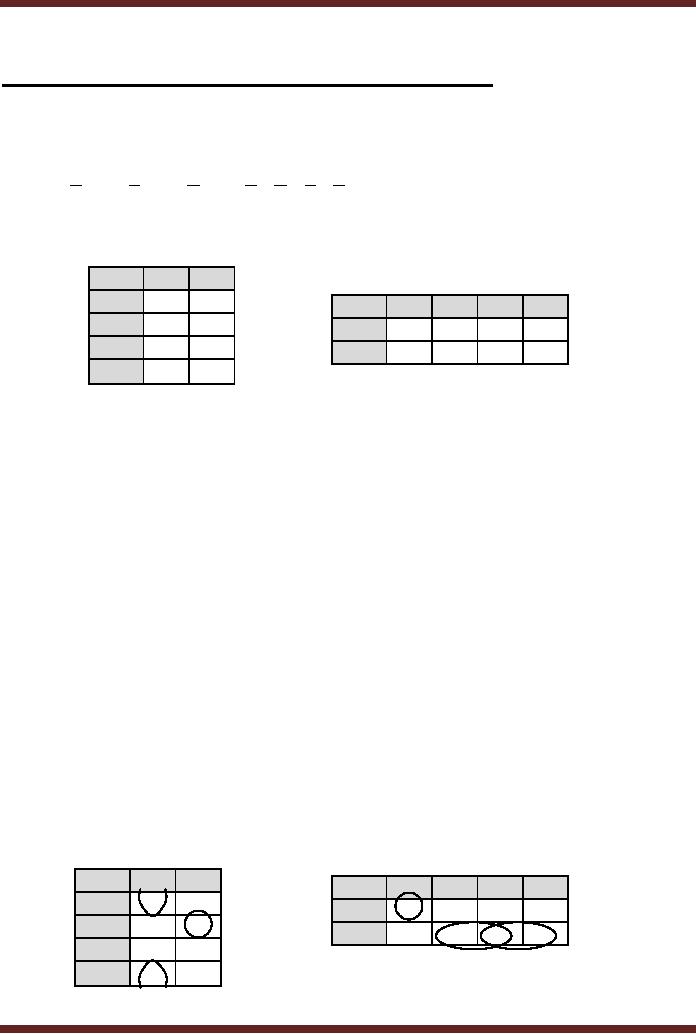
CS302 -
Digital Logic & Design
Lesson
No. 11
KARNAUGH MAP &
BOOLEAN EXPRESSION
SIMPLIFICATION
Mapping a
Standard POS
Expression
For a
Standard POS expression, a 0 is
placed in the cell
corresponding to the
product
term
(maxterm) present in the
expression. The cells are
not filled with 0s have
1s. The
Standard
POS
expression
having
a
Domain
of
three
variables
(A + B + C).(A + B + C).(A + B + C).(A + B + C) uses a
3-Variable Karnaugh Map. The
sum
terms or
the Maxterms are 1, 2, 5 and
7. The expression can be
represented by a K-Map by
placing a 0 at
Maxterm locations 1, 2, 5 and 7
and placing 1 at remaining
places. Any of the
two
K-maps can be used. Figure
11.1.
AB\C
0
1
00
1
0
A\BC
00
01
11
10
01
0
1
0
1
0
1
0
11
1
0
1
1
0
0
1
10
1
0
Figure
11.1
Mapping a
Standard POS
expression
Karnaugh
Map simplification of POS
expressions
POS
expressions can be easily
simplified by use of the
K-Map in a manner similar
to
the
method adopted for
simplifying SOP expressions.
After the POS expression is
mapped on
the
K-map, groups of 0s are
marked instead of 1s based on
the rules for forming
groups used
for
simplifying SOP.
In the
next step minimal sum
terms are determined. Each
group, including a
group
having a
single cell, represents a
sum term having variables
that occur in only one
form either
complemented or
un-complemented.
A 3-variable
K-map yields
· A sum
term of three variables for
a group of 1 cell
· A sum
term of two variables for a
group of 2 cell
· A sum
term of one variable for a
group of 4 cell
· A group of
8 cells yields a value of 0
for the expression.
A 4-variable
K-map yields
· A sum
term of four variables for a
group of 1 cell
· A sum
term of three variables for
a group of 2 cell
· A sum
term of two variables for a
group of 4 cell
· A sum
term of one variable for a
group of 8 cell
· A group of
16 cells yields a value of 0
for the expression.
Example 1 &
2
0
1
AB\C
00
01
11
10
A\BC
00
0
1
0
0
1
1
1
01
1
0
1
1
0
0
0
11
1
1
10
0
1
Figure
11.2
Simplification
of POS expression using a
3-variable K-Map
99
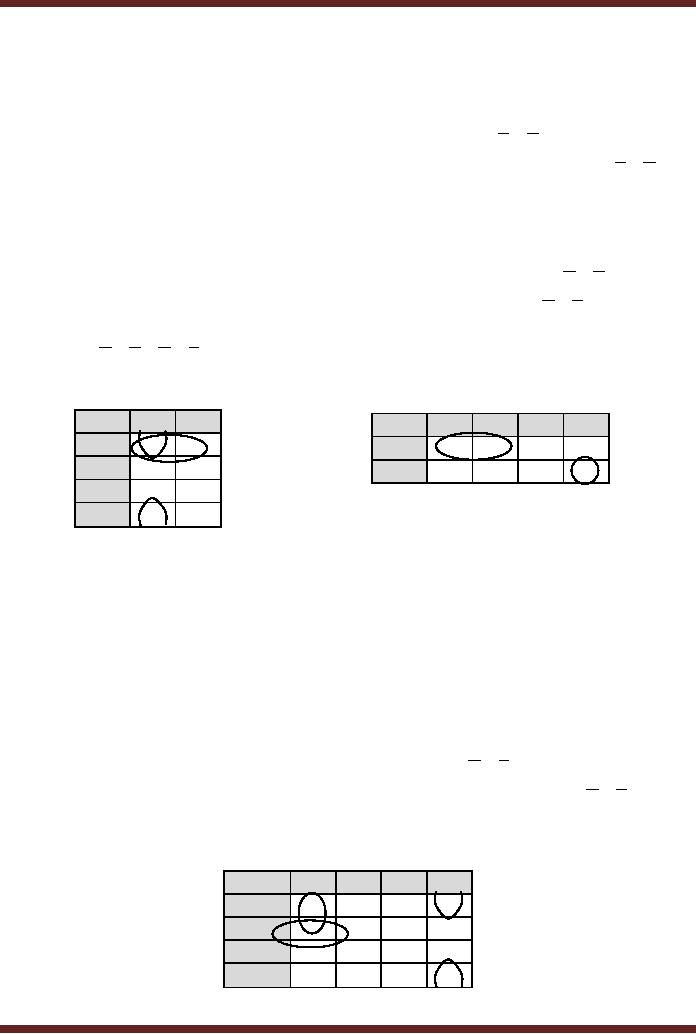
CS302 -
Digital Logic & Design
A POS
expression having 3 Maxterms is
mapped to a 3-variable column
based K-map.
A single
group of two cells and a
group of one cell are
formed.
· The
first group of 0s comprising of
cells 0 and 4 forms the
sum term (B + C)
The
second group comprising of
cell 3 forms the sum
term (A + B + C)
·
The
three term POS expression
simplifies to a 2 term POS
expression (B + C).(A + B + C) .
A POS
expression having 4 Maxterms is
mapped to a 3-variable column
based K-map.
Two
groups of 2 cells each and a
third group of single cell
are formed.
· The
single cell group comprising
of cell 0 forms the sum
term (A + B + C)
The
second group of 0s comprising of
cells 5 and 7 forms the
sum term (A + C)
·
· The
third group of 0s comprising of
cells 6 and 7 forms the
sum term (A + B)
The
four term POS
expression simplifies to a
3 term POS
expression
(A + B + C).(A + C).(A + B) .
Example 3 &
4
0
1
AB\C
00
01
11
10
A\BC
0
0
00
0
0
0
1
1
1
1
01
1
1
1
1
0
1
1
11
0
1
10
Figure
11.3
Simplification
of POS expression using a
3-variable K-Map
A POS
expression having 3 Maxterms is
mapped to a 3-variable column
based K-map.
Two
groups of two cells are
formed.
· The
first group of 0s comprising of
cells 0 and 1 forms the
sum term (A + B)
· The
second group of 0s comprising of
cells 0 and 4 forms the
sum term (B + C)
The
three term POS expression
simplifies to a 2 terms POS
expression (A + B).(B + C)
A POS
expression having 3 Maxterms is
mapped to a 3-variable column
based K-map.
One
group of 2 cells and another
group of single cell are
formed.
· The
first group of 0s comprising of
cell 0 and 1 forms the
sum term (A + B)
The
second group comprising of
cell 6 forms the sum
term (A + B + C)
·
The
three term POS expression
simplifies to a 2 term POS
expression (A + B).(A + B + C)
Example
5
AB\CD
00
01
11
10
0
0
00
1
1
01
0
0
1
1
1
11
1
1
1
10
1
1
1
0
100
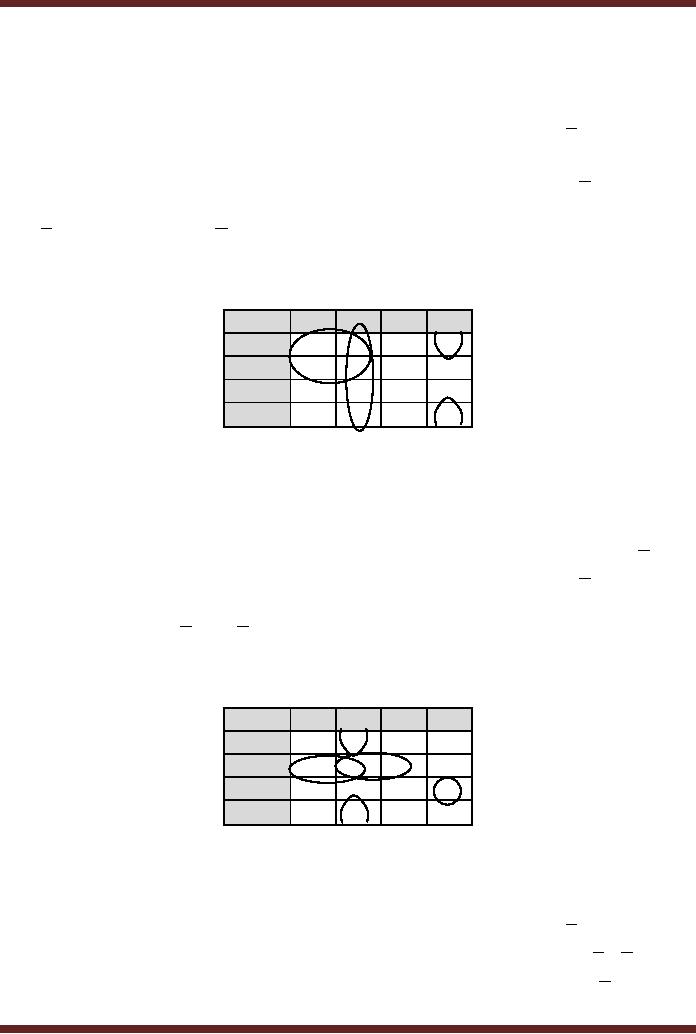
CS302 -
Digital Logic & Design
Figure
11.4
Simplification
of POS expression using a
4-variable K-Map
A POS
expression having 5 Maxterms is
mapped to a 4-variable column
based K-map.
Three
groups of two cells are
formed.
The
first group of 0s comprising of
cells 4 and 5 forms the
sum term (A + B + C)
·
The
second group of 0s comprising of
cells 0 and 4 forms the
sum term (A + C + D)
·
· The
third group of 0s comprising of
cells 2 and 10 forms the
sum term (B + C + D)
The
five term POS
expression has reduced
to a 3 term POS
expression
(A + B + C).(A + C + D).(B + C + D)
Example
6
11
10
AB\CD
00
01
00
0
0
1
0
01
0
0
1
1
11
1
0
1
1
0
10
1
0
1
Figure
11.5
Simplification
of POS expression using a
4-variable K-Map
A POS
expression having 8 Maxterms is
mapped to a 4-variable column
based K-map.
Two
groups of 4 cells and one
group of two cells are
formed.
· The
first group of 0s comprising of
cells 0, 1, 4 and 5 forms
the sum term (A + C)
The
second group of 0s comprising of
cells 1, 5, 9 and 13 forms
the sum term (C + D)
·
· The
third group of 0s comprising of
cells 2 and 10 forms the
sum term (B + C + D)
The
eight
term
POS
expression
has
reduced
to
a
3
term
POS
expression
(A + C).(C + D).(B + C + D) .
Example
7
01
AB\CD
00
11
10
00
1
0
1
1
0
01
0
0
1
11
1
0
1
1
10
1
0
1
1
Figure
11.6
Simplification
of POS expression using a
4-variable K-Map
A POS
expression having 6 Maxterms is
mapped to a 4-variable column
based K-map.
Three
groups of 2 cells and one
group of a single cell are
formed.
· The
first group of 0s comprising of
cells 4 and 5 forms the
sum term (A + B + C)
The
second group of 0s comprising of
cells 5 and 7 forms the
sum term (A + B + D)
·
The
third group of 0s comprising of
cells 1 and 9 forms the
sum term (B + C + D)
·
101
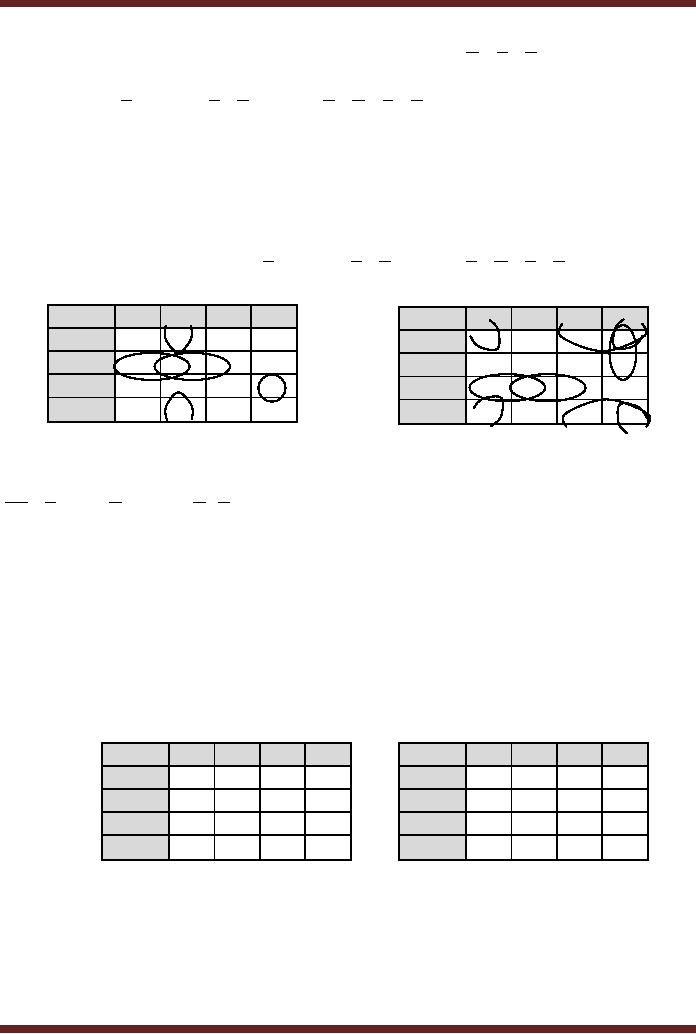
CS302 -
Digital Logic & Design
· The
fourth group comprising of
cell 14 forms the sum
term (A + B + C + D)
The
six
term
POS
expression
has
reduced
to
a
4
term
POS
expression
(A + B + C).(A + B + D).(B + C + D).(A + B + C + D)
Converting
between POS and SOP
using the K-map
Converting
between the two forms of
standard expressions is very
simple. If the 1s
mapped on
the K-map are grouped
together they form the
product terms of the
SOP
expression.
Similarly, if the 0s mapped on
the K-map are grouped
together they form the
sum
terms of
the POS expression
Consider
the POS expression (A + B + C).(A + B + D).(B + C + D).(A + B + C + D)
01
AB\CD
00
11
10
00
01
10
AB\CD
11
00
1
0
1
1
00
1
0
1
1
01
0
0
0
1
01
0
0
0
1
11
1
0
1
1
11
1
1
1
0
1
1
1
10
1
0
1
1
10
0
Figure
11.7
Converting
between SOP and POS
using K-map
An equivalent
SOP expression can be
obtained by grouping the 1s
together.
BD + BC + ABC + ABD + ACD
Five-Variable
Karnaugh Map
A K-map
for 5 variables can be
constructed by using two
4-variable K-maps.
Figure
11.8.
The cells 0 to 15 lie in the
4-variable map A=0 and
cells 16 to 31 lie in the
4-variable map
A=1.
The
two, 4-variable maps are
considered to be lying on top of
each other. Thus a
two
dimensional
map is formed. Rules for
grouping of 0s and 1s remain
unchanged. In a 2-
dimensional
map, the groups of adjacent
0s or 1s can also span both
the maps. In a
5-variable
Karnaugh
map groups of 2, 4, 8, 16 and 32
can be formed.
BC\DE
00
01
11
10
BC\DE
00
01
11
10
00
0
1
3
2
00
16
17
19
18
01
4
5
7
6
01
20
21
23
22
11
12
13
15
14
11
28
29
31
30
10
8
9
11
10
10
24
25
27
26
Figure
11.8
5-variable
Karnaugh Map using A=0 and
A=1 maps
Mapping,
Grouping and Simplification
using 5-variable Karnaugh
maps is identical to
those of 3
and 4 variable Karnaugh
maps.
102
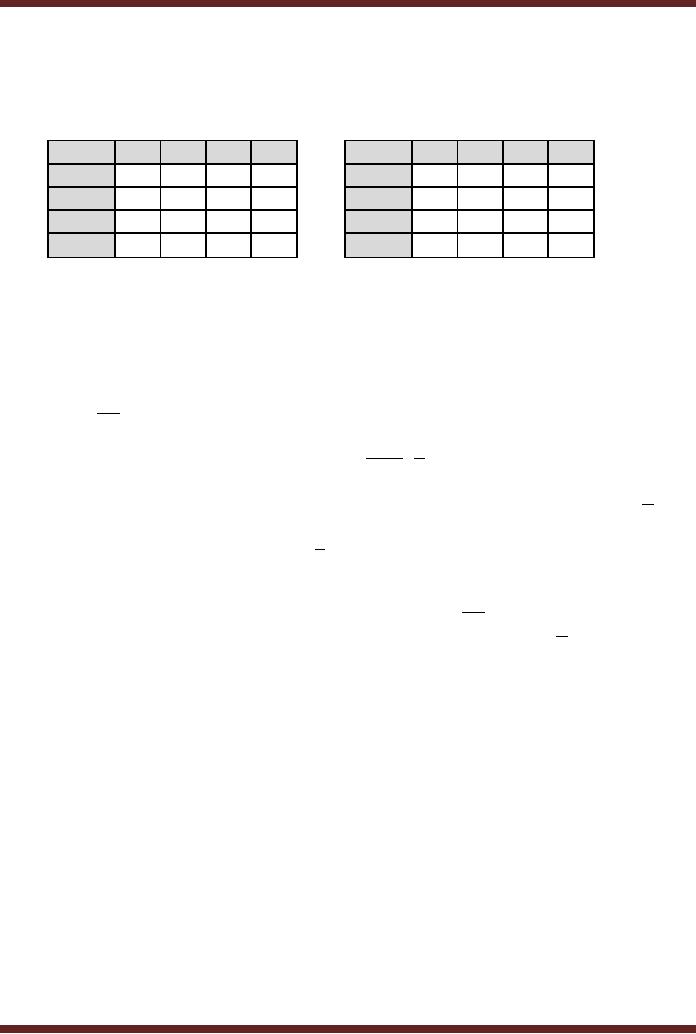
CS302 -
Digital Logic & Design
Simplification of
5-Variable Karnaugh
Map
BC\DE
00
01
11
10
BC\DE
00
01
11
10
00
0
1
0
1
00
1
1
0
0
01
0
1
0
0
01
1
1
0
0
11
0
0
0
1
11
0
0
0
1
10
0
0
1
1
10
0
1
1
1
Figure
11.9
5-variable
Karnaugh Map Simplification
The
5-variable Karnaugh map is
mapped with Minterms in
plane A=0 and
A=1
respectively.
Consider the groups that
are formed.
·
Starting
with A=0 map. The
cells 1 and 5 form a group
of two cells. These two
cells along
with
cells 17 and 21 in map A=1
from a group of 4 cells.
This group of 4 cells
represents
the
term BDE
·
The
cell 2 in map A=0. Cell 2
does not form a group
with any adjacent cells.
Therefore it is
a group of
single cell having the
product term ABCDE
·
The
cells 10 and 11 in map A=0.
These two cells form a
group of four with adjacent
cells
26 and 27 in
map A=1. Therefore the
group of 4 cells represents
the product term BCD
·
Tthe
cells 11 and 14 in map A=0
and cells 26 and 30 in map
A=1represent a group of 4
cells
representing the product
term BDE
Now
considering the map
A=1.
· The 4
cells 16, 17, 20 and 21
represent the product term
ABD
· The
cell 25 along with cell 27
in map A=1 represent the
product term ABCE
Functions
having multiple
outputs
In the
discussions on Boolean expressions
and Function Tables that
represent
Boolean
functions it has been
assumed that Logic Circuits
have multiple inputs and
single
output.
Practical Logic circuits
however, have multiple
inputs and multiple outputs.
Circuits
having a
single output or multiple
outputs are treated in the
same manner.
Circuits
having multiple outputs are
represented by multiple function
tables one for
each
output or a single function
table having multiple output
columns. The example of a
BCD
to 7-Segment
Decoder circuit which has 4
inputs and 7 outputs is
considered to explain
functions
having multiple
outputs.
7-Segment
Display
The
7-segment display digit is
shown. Figure 11.10.
7-Segment Display is used
to
display
the decimal numbers 0 to 9. A
7-segment display digit has
7 segments a, b, c, d, e, f
and g
that are turned on/off by a
digital circuit depending
upon the number that is to
be
displayed.
103
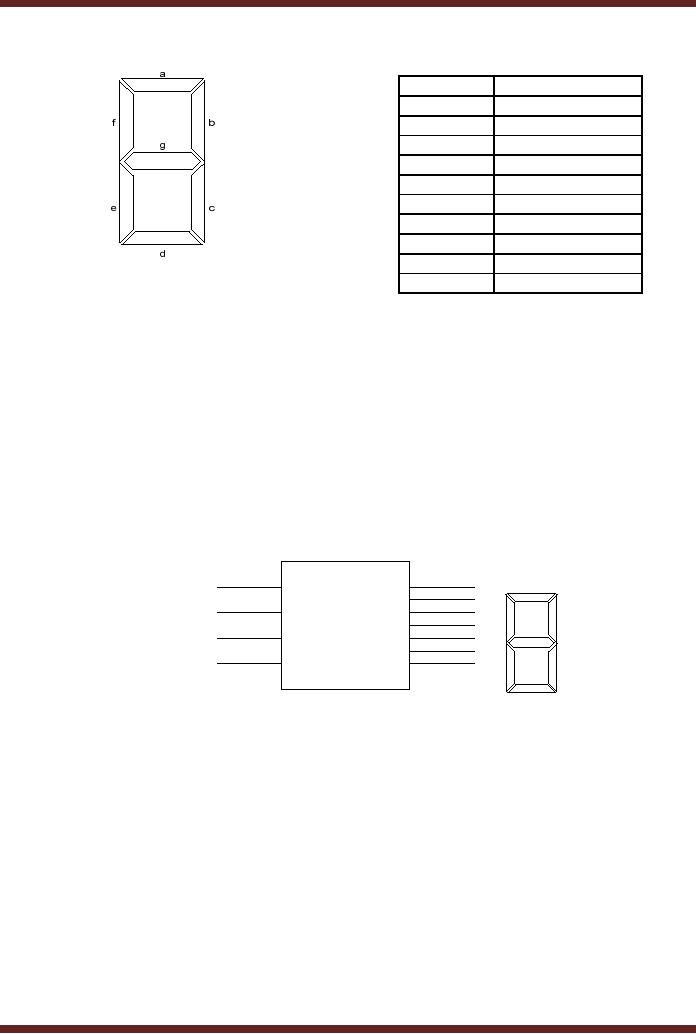
CS302 -
Digital Logic & Design
Digit
Segments
0
a, b, c, d, e,
f
1
b, c
2
a, b, d, e,
g
3
a, b, c, d,
g
4
b, c, f,
g
5
a, c , d, f,
g
6
a, c, d, e, f,
g
7
a, b, c
8
a, b, c, d, e, f,
g
9
a, b, c, d, f,
g
Figure
11.10 7-Segment
Display
Different
set of segments have to be
turned on to display different
digits. For example,
to display
the digit 3, segments a, b, c, d
and g have to be turned on.
To display the digit
7,
segments a, b
and c have to be turned on.
The table indicates the
segments that are turned
on
for
each digit.
The
circuit that turns on the
appropriate segments to display a
digit is known as a
BCD
to 7-Sement
Decoder. The input to the
BCD to 7-Segment decoder
circuit is a 4-bit
BCD
number
between 0 and 9. The seven
output lines of the decoder
connect to the 7
segments.
Figure
11.11.
7-segment
output
4-bit
a
Logic
BCD
f
b
Circuit
g
input
e
c
d
Figure
11.11 BCD to 7-Segment
Decoder
To implement
the decoder circuit having 4
inputs and 7 outputs,
function tables have
to
be drawn
which represent the output
status of each output line
for all combinations of
inputs.
For
example, the segment a is
turned on when the 4-bit
input is 0, 2, 3, 5, 6, 7, 8 and
9.
Similarly,
the segment b is turned on
for 0, 2, 3, 4, 7, 8 and 9 combinations
of inputs. Thus
seven
expressions, one for each
segment has to be be determined
before the decoder
circuit
can be
implemented.
Seven
function tables are required
to represent the input/output
combinations for each
segment.
The seven function tables
for segments a, b, c, d, e, f and g
are shown. Figure
11.12a-g. To
determine the seven
expressions for each of the
seven outputs, seven
4-variable
Karnaugh
maps are used. The
Karnaugh maps and the
simplified expressions are
shown.
Figure
11.13a-g. An alternate way of
representing the seven
Function tables is to have
a
single
function table with the
four columns representing
the 4-bit input BCD
number and seven
104
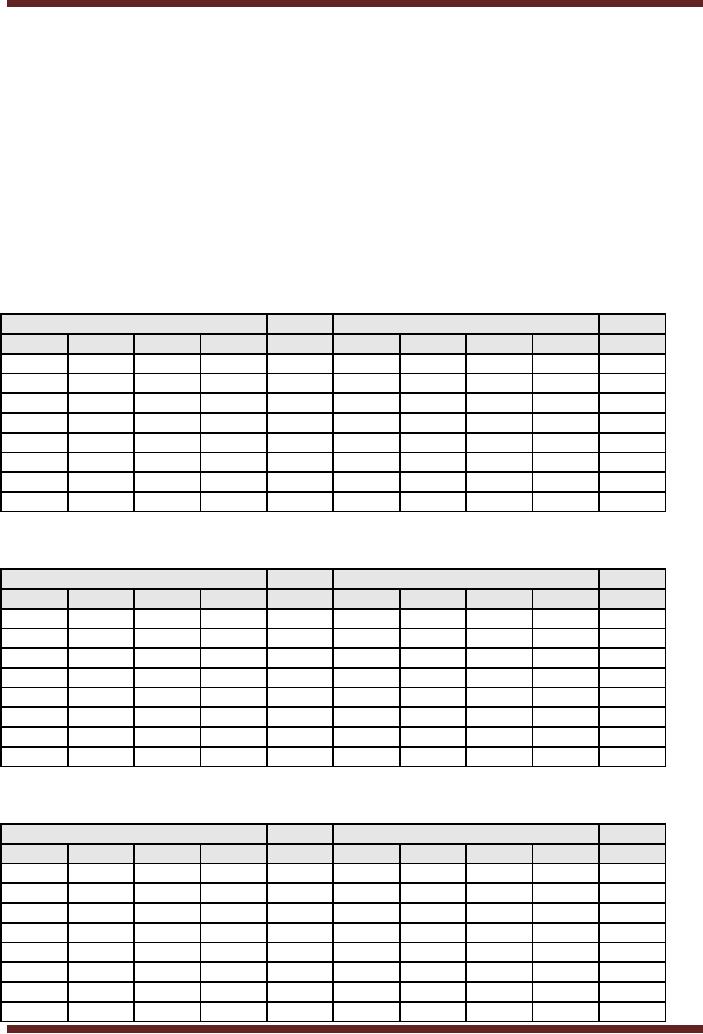
CS302 -
Digital Logic & Design
output
columns each representing
one of the seven segments a,
b, c, d, e, f and g
respectively.
Since
the 4-bit input to the
decoder circuit can have 16
possible input
combinations,
therefore
each of the seven Function
tables have sixteen input
combinations. However,
the
last 6
input combinations are don't
care as these combinations
never occur because the
input
to the
circuit is a 4-bit BCD
number. The don't care
states help in simplifying
the Boolean
expressions
for the seven
segments.
Input
Output
Input
Output
A
B
C
D
Seg.
a
A
B
C
D
Seg.
a
0
0
0
0
1
1
0
0
0
1
0
0
0
1
0
1
0
0
1
1
0
0
1
0
1
1
0
1
0
x
0
0
1
1
1
1
0
1
1
x
0
1
0
0
0
1
1
0
0
x
0
1
0
1
1
1
1
0
1
x
0
1
1
0
1
1
1
1
0
x
0
1
1
1
1
1
1
1
1
x
Figure
11.12a
Function
Table for Segment a
Input
Output
Input
Output
A
B
C
D
Seg.
b
A
B
C
D
Seg.
b
0
0
0
0
1
1
0
0
0
1
0
0
0
1
1
1
0
0
1
1
0
0
1
0
1
1
0
1
0
x
0
0
1
1
1
1
0
1
1
x
0
1
0
0
1
1
1
0
0
x
0
1
0
1
0
1
1
0
1
x
0
1
1
0
0
1
1
1
0
x
0
1
1
1
1
1
1
1
1
x
Figure
11.12b
Function
Table for Segment b
Input
Output
Input
Output
A
B
C
D
Seg.
c
A
B
C
D
Seg.
c
0
0
0
0
1
1
0
0
0
1
0
0
0
1
1
1
0
0
1
1
0
0
1
0
0
1
0
1
0
X
0
0
1
1
1
1
0
1
1
X
0
1
0
0
1
1
1
0
0
X
0
1
0
1
1
1
1
0
1
x
0
1
1
0
1
1
1
1
0
x
0
1
1
1
1
1
1
1
1
x
105
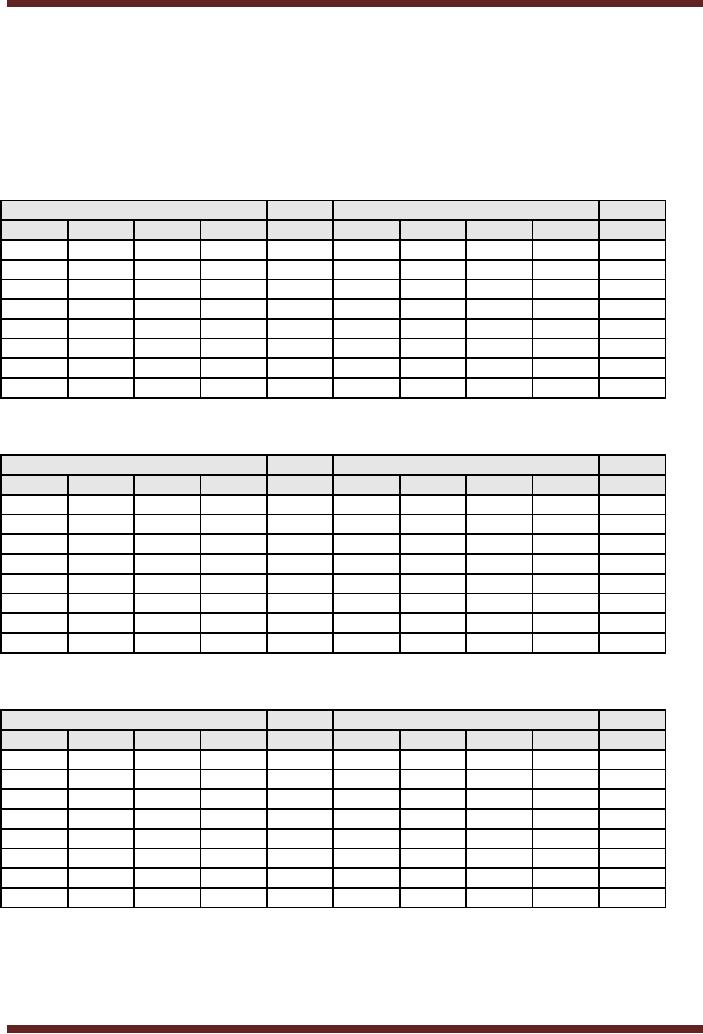
CS302 -
Digital Logic & Design
Figure
11.12c
Function
Table for Segment c
Input
Output
Input
Output
A
B
C
D
d
A
B
C
D
d
0
0
0
0
1
1
0
0
0
1
0
0
0
1
0
1
0
0
1
1
0
0
1
0
1
1
0
1
0
x
0
0
1
1
1
1
0
1
1
x
0
1
0
0
0
1
1
0
0
x
0
1
0
1
1
1
1
0
1
x
0
1
1
0
1
1
1
1
0
x
0
1
1
1
0
1
1
1
1
x
Figure
11.12d
Function
Table for Segment d
Input
Output
Input
Output
A
B
C
D
Seg.
e
A
B
C
D
Seg.
e
0
0
0
0
1
1
0
0
0
1
0
0
0
1
0
1
0
0
1
0
0
0
1
0
1
1
0
1
0
x
0
0
1
1
0
1
0
1
1
x
0
1
0
0
0
1
1
0
0
x
0
1
0
1
0
1
1
0
1
x
0
1
1
0
1
1
1
1
0
x
0
1
1
1
0
1
1
1
1
x
Figure
11.12e
Function
Table for Segment e
Input
Output
Input
Output
A
B
C
D
Seg.
f
A
B
C
D
Seg.
f
0
0
0
0
1
1
0
0
0
1
0
0
0
1
0
1
0
0
1
1
0
0
1
0
0
1
0
1
0
x
0
0
1
1
0
1
0
1
1
x
0
1
0
0
1
1
1
0
0
x
0
1
0
1
1
1
1
0
1
x
0
1
1
0
1
1
1
1
0
x
0
1
1
1
0
1
1
1
1
x
Figure
11.12f
Function
Table for Segment f
106
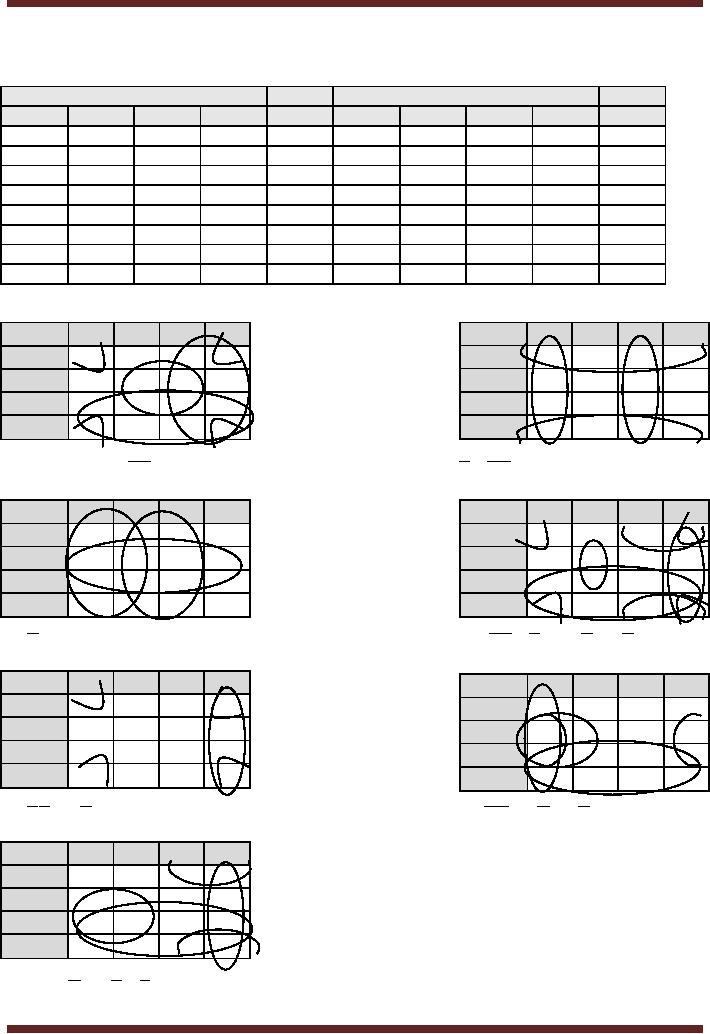
CS302 -
Digital Logic & Design
Input
Output
Input
Output
A
B
C
D
Seg.
g
A
B
C
D
Seg.
g
0
0
0
0
0
1
0
0
0
1
0
0
0
1
0
1
0
0
1
1
0
0
1
0
1
1
0
1
0
x
0
0
1
1
1
1
0
1
1
x
0
1
0
0
1
1
1
0
0
x
0
1
0
1
1
1
1
0
1
x
0
1
1
0
1
1
1
1
0
x
0
1
1
1
0
1
1
1
1
x
Figure
11.12g
Function
Table for Segment g
00
11
11
10
AB\CD
01
10
AB\CD
00
01
00
1
0
1
1
1
1
00
1
1
0
01
1
0
1
0
01
1
1
1
11
x
x
x
x
11
x
x
x
X
10
1
x
1
1
x
x
10
1
x
a = A + C + BD + BD
b = B + CD + CD
AB\CD
01
10
00
11
10
AB\CD
00
01
11
00
00
0
1
1
1
1
1
0
1
01
0
1
0
1
01
1
1
1
1
11
x
x
x
x
11
x
x
x
x
1
x
x
10
1
1
x
x
10
1
c = C+D+B
d = A + BD + BC + CD + BCD
00
10
AB\CD
01
11
AB\CD
00
01
11
10
00
1
0
0
1
00
1
0
0
0
01
0
0
0
1
01
1
1
0
1
x
x
11
x
x
11
x
x
x
x
10
1
0
x
x
10
1
1
x
x
e = BD + CD
f = B + CD + BC + BD
11
10
AB\CD
00
01
00
0
0
1
1
1
01
1
0
1
x
11
x
x
x
10
1
1
x
x
g = A + BC + CD + BC
107

CS302 -
Digital Logic & Design
Figure
11.13a-g
Karnaugh
Maps and Simplified Boolean
Expressions for Display
Segments
a to g
108
Table of Contents:
- AN OVERVIEW & NUMBER SYSTEMS
- Binary to Decimal to Binary conversion, Binary Arithmetic, 1’s & 2’s complement
- Range of Numbers and Overflow, Floating-Point, Hexadecimal Numbers
- Octal Numbers, Octal to Binary Decimal to Octal Conversion
- LOGIC GATES: AND Gate, OR Gate, NOT Gate, NAND Gate
- AND OR NAND XOR XNOR Gate Implementation and Applications
- DC Supply Voltage, TTL Logic Levels, Noise Margin, Power Dissipation
- Boolean Addition, Multiplication, Commutative Law, Associative Law, Distributive Law, Demorgan’s Theorems
- Simplification of Boolean Expression, Standard POS form, Minterms and Maxterms
- KARNAUGH MAP, Mapping a non-standard SOP Expression
- Converting between POS and SOP using the K-map
- COMPARATOR: Quine-McCluskey Simplification Method
- ODD-PRIME NUMBER DETECTOR, Combinational Circuit Implementation
- IMPLEMENTATION OF AN ODD-PARITY GENERATOR CIRCUIT
- BCD ADDER: 2-digit BCD Adder, A 4-bit Adder Subtracter Unit
- 16-BIT ALU, MSI 4-bit Comparator, Decoders
- BCD to 7-Segment Decoder, Decimal-to-BCD Encoder
- 2-INPUT 4-BIT MULTIPLEXER, 8, 16-Input Multiplexer, Logic Function Generator
- Applications of Demultiplexer, PROM, PLA, PAL, GAL
- OLMC Combinational Mode, Tri-State Buffers, The GAL16V8, Introduction to ABEL
- OLMC for GAL16V8, Tri-state Buffer and OLMC output pin
- Implementation of Quad MUX, Latches and Flip-Flops
- APPLICATION OF S-R LATCH, Edge-Triggered D Flip-Flop, J-K Flip-flop
- Data Storage using D-flip-flop, Synchronizing Asynchronous inputs using D flip-flop
- Dual Positive-Edge triggered D flip-flop, J-K flip-flop, Master-Slave Flip-Flops
- THE 555 TIMER: Race Conditions, Asynchronous, Ripple Counters
- Down Counter with truncated sequence, 4-bit Synchronous Decade Counter
- Mod-n Synchronous Counter, Cascading Counters, Up-Down Counter
- Integrated Circuit Up Down Decade Counter Design and Applications
- DIGITAL CLOCK: Clocked Synchronous State Machines
- NEXT-STATE TABLE: Flip-flop Transition Table, Karnaugh Maps
- D FLIP-FLOP BASED IMPLEMENTATION
- Moore Machine State Diagram, Mealy Machine State Diagram, Karnaugh Maps
- SHIFT REGISTERS: Serial In/Shift Left,Right/Serial Out Operation
- APPLICATIONS OF SHIFT REGISTERS: Serial-to-Parallel Converter
- Elevator Control System: Elevator State Diagram, State Table, Input and Output Signals, Input Latches
- Traffic Signal Control System: Switching of Traffic Lights, Inputs and Outputs, State Machine
- Traffic Signal Control System: EQUATION DEFINITION
- Memory Organization, Capacity, Density, Signals and Basic Operations, Read, Write, Address, data Signals
- Memory Read, Write Cycle, Synchronous Burst SRAM, Dynamic RAM
- Burst, Distributed Refresh, Types of DRAMs, ROM Read-Only Memory, Mask ROM
- First In-First Out (FIFO) Memory
- LAST IN-FIRST OUT (LIFO) MEMORY
- THE LOGIC BLOCK: Analogue to Digital Conversion, Logic Element, Look-Up Table
- SUCCESSIVE –APPROXIMATION ANALOGUE TO DIGITAL CONVERTER